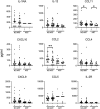Herpes Simplex Virus Type 2 Prevalence and Association with Inflammatory Cytokines Among Sexual and Gender Minorities Living With and Without HIV-1 from Lagos, Nigeria
- PMID: 36825536
- PMCID: PMC10510689
- DOI: 10.1089/AID.2022.0070
Herpes Simplex Virus Type 2 Prevalence and Association with Inflammatory Cytokines Among Sexual and Gender Minorities Living With and Without HIV-1 from Lagos, Nigeria
Abstract
Herpes simplex virus type 2 (HSV-2) is common globally and contributes significantly to the risk of acquiring HIV-1, yet these two sexually transmitted infections have not been sufficiently characterized for sexual and gender minorities (SGM) across Sub-Saharan Africa. To help fill this gap, we performed a retrospective study using plasma and serum samples from 183 SGM enrolled at the Lagos site of the TRUST/RV368 cohort in Nigeria, assayed them for HSV-2 antibodies with the Kalon ELISA and plasma cytokines and chemokines with Luminex, and correlated the findings with HIV-1 viral loads (VLs) and CD4 counts. We found an overall HSV-2 prevalence of 36.6% (49.5% and 23.9% among SGM with and without HIV-1, respectively, p < .001). Moreover, HSV-2-positive status was associated with high circulating concentrations of CCL11 among antiretroviral therapy-treated (p = .031) and untreated (p = .015) participants, and with high concentrations of CCL2 in the untreated group (p = .004), independent of VL. Principal component analysis revealed a strong association of cytokines with HIV-1 VL independent of HSV-2 status. In conclusion, our study finds that HSV-2 prevalence among SGM with HIV-1 is twice as high than HSV-2 prevalence among SGM without HIV-1 in Lagos and suggests that this is associated with higher levels of certain systemic cytokines. Additional work is needed to further characterize the relationship between HSV-2 and HIV-1 in SGM and help develop targeted therapies for coinfected individuals.
Keywords: HIV; HSV-2; STI; anorectal; inflammation.
Conflict of interest statement
The authors declare no conflicts of interest.
Figures



References
-
- Looker KJ, Welton NJ, Sabin KM, et al. Global and regional estimates of the contribution of herpes simplex virus type 2 infection to HIV incidence: A population attributable fraction analysis using published epidemiological data. Lancet Infect Dis 2020;20(2):240–249; doi: 10.1016/S1473-3099(19)30470-0 - DOI - PMC - PubMed
-
- Schelar E, Polis C, Essam T, et al. Multipurpose prevention technologies for sexual and reproductive health: Mapping global needs for introduction of new preventive products. Contraception 2016;93(1):32–43. - PubMed
Publication types
MeSH terms
Substances
Grants and funding
LinkOut - more resources
Full Text Sources
Medical
Research Materials
Miscellaneous

